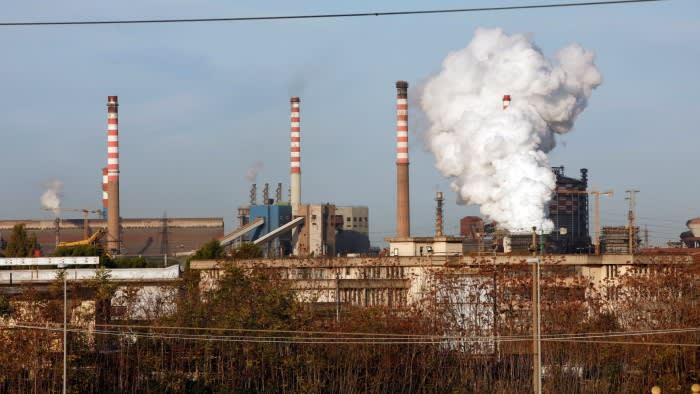
Unlock the Editor’s Digest for free
Roula Khalaf, Editor of the FT, selects her favourite stories in this weekly newsletter.
European steelmakers are caught in a hot coil. Local lawmakers are pushing them to decarbonise. Yet a full-scale conversion to clean steel production risks worsening their already rickety global competitive position.
Europe’s steel plants know they will need to pay the full cost of carbon dioxide emissions by 2034. That might add €200 to the cost of each metric tonne of steel produced in blast furnaces — almost 30 per cent of today’s price.
This makes investment in clean technologies — including electric arc furnaces to recycle scrap metal and direct reduction facilities — look attractive. A DRI plant with 2mn tonnes of annual capacity might cost a couple of billion euros to build, adding roughly €50 to each tonne.
Europe’s steelmakers hope to revive some moribund plants in this way. Italy’s industry association has called for subsidies to support the steel mill formerly known as Ilva. In Germany, Thyssenkrupp has secured €2bn, while ArcelorMittal will get a package worth as much as €850mn in France.

This may make sense in some locations, but not everywhere. Building DRI facilities is not sufficient. Running these requires green hydrogen, made using renewable power. In much of Europe, that will be expensive.
For an idea of the cost, consider that a 2mn-tonne DRI plant will need perhaps 6 terawatt hours (TWh) of electricity a year. At an all-in cost of €80/MWh, that’s a €480mn power bill. The same mill built in a green electricity sweet spot, where costs are perhaps €30/MWh, would save €300mn.
Such economics are available in some European locations and help explain how H2 Green Steel — a greenfield project positioned near low-cost Swedish hydropower — secured €4bn in financing last week.
But traditional steel plants usually don’t have the fortune of co-location with cheap renewables. That leaves them exposed to competition from enterprising newcomers.
Moving clean energy around is an oft-touted solution. But steelmakers might also wish to rethink their inputs. Reduce iron ore where green power is cheap, and then ship this to steel mills.
In an era of snarled-up supply chains and reshoring, this may not appeal to all. But it could preserve steelmaking capabilities in Europe. This could protect perhaps two-thirds of the labour force of a traditional plant, according to the Rocky Mountains Institute. And, in a crunch, creative solutions should not be ruled out.
Lex is the FT’s flagship daily investment column. If you are a subscriber and would like to receive alerts when Lex articles are published, just click the button ‘Add to myFT’, which appears at the top of this page above the headline


